what advantage did tycho have compared to other astronomical observers of his time
Medieval & Renaissance Astronomy
- Medieval Astronomy
- Renaissance Astronomy
- Nicolaus Copernicus
- Tycho Brahe
- Johannes Kepler
Medieval Astronomy
Reverse to mutual misconception the period betwixt the end of the classical era and the get-go of the Renaissance was not devoid of scientific progress. Islamic scholars translated many of the surviving writings from Greek or Syriac into Standard arabic from the late 700's onwards. These translations in turn were transported into Islamic Spain where they eventually barbarous into Christian easily and were translated into Latin. Islamic astronomers such as Muhammad al-Battani (c. 850 - 929) refined Ptolemy's model and their published works and tables were after used by Western astronomers. Even today the influence of Islamic astronomers is found in the names of many of the vivid stars such every bit Betelgeuse (α Ori), Alnitak (ζ Ori) and Zubenelgenubi (α Lib).
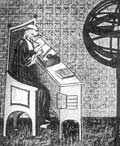
Nicole Oresme
As Western scholars studied the Latin translations of the classical philosophers they incorporated many aspects of their work into the prevailing theology and world view. Aristotle's physics described the motion of objects and the refined model of Ptolemy was used to report the night sky. The Frenchman, Nicole Oresme (1320 - 82) applied an early concept of the middle of gravity, used mathematics to contend against astrology and fifty-fifty suggested the existence of other inhabited worlds in space. Nicolas of Cusa (born c. 1401) supported this idea and rejected the concept of a static Earth at the centre of all motions.
Georg Puerbach (1423 - 61) refined the Almagest and wrote a popular textbook on it. This prompted a renewal of interest in the need for authentic observations. His pupil, Regiomontanus (1436 - 76) highlighted bug with Ptolemy'southward piece of work based on observations made at his purpose-congenital observatory. He published his own and other writings on astronomy and the increasing availability of printed books did much to spread ideas amidst scholars. In 1482 he observed a bright comet that was later on identified equally i of the visits of Comet Halley and was most likely working towards a heliocentric model influenced by Aristarchus at the time of his death.
The Renaissance
Nicolaus Copernicus (1473 - 1543)

Nicolaus Copernicus
Copernicus studied classics and mathematics at Cracow in his native Poland, catechism law in Bologna and Ferrara and medicine at Padua in Italy. His neat interest in astronomy was fostered in Italy and developed back in Poland where he was canon at the cathedral in Frauenberg (now Frombeck) where he spent well-nigh of his life.
A conjunction of Jupiter and Saturn in 1504 was observed to differ past ten days from the predictions of tables based on Ptolemy's work. This, combined with Copernicus' abhorrence of the equant drove him to develop an improved model. Influenced by the piece of work of Regiomontanus (thus also Aristarchus) and neoplatonism (which viewed the Sun every bit the Godhead and source of all knowledge) he produced his own model. He withheld publication due to his conservative nature and fear of ridicule but was eventually persuaded past Rheticus. Allegedly he received the start copy of his piece of work De revolutionibus orbium (On the revolution of the heavenly spheres) on his deathbed in 1543.
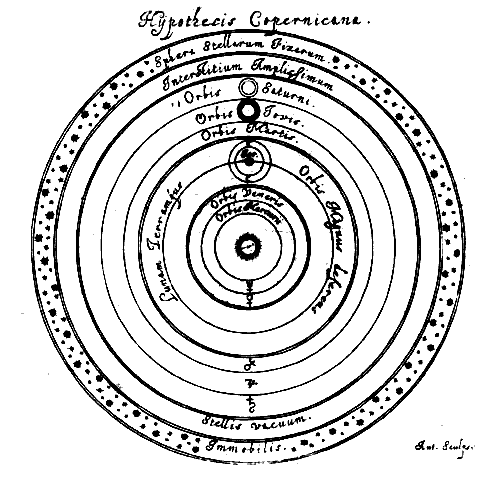
Manuscript example of Copernicus' model.
In Copernicus' model a spherical Globe rotates daily on information technology axis whilst it and the other planets each orbit the Sun. The period of the planets' orbits increases with increasing distance from the Sun. The Sun was non exactly at the heart of the planetary orbits thus strictly speaking the model is heliostatic rather than heliocentric.
There were several advantages of Copernicus' model over that of Ptolemy:
- It could predict planetary positions to within 2°, the aforementioned equally that of Ptolemy.
- Retrograde motion of planets was explained by the relative movement between them and the Earth.
- Distances between planets and the Sun could be accurately adamant in units of the Earth-Sun distance (ie Astronomical Units).
- Orbital periods could exist accurately determined.
- It explained the deviation betwixt the inferior planets (Mercury and Venus) that were always observed shut to the Sun and the superior ones (Mars, Jupiter and Saturn).
- It preserved the concept of uniform round motion without the need for equants.
- Information technology preserved Aristotle'due south concept of real spheres nestled inside one another.
- Unlike Ptolemy'due south model it did not require the Moon to modify in size.
Copernicus' model also had several problems which contributed to its failure to immediately supplant Ptolemy's model:
- No annual stellar parallax could be detected. Copernicus explained this equally due to the fact that the stars were a vast distance hence any parallax would be very small and difficult to observe.
- Information technology required a moving World, This would contradict Aristotelian physics and Copernicus presented no new laws of motility to supersede Aristotle.
- By removing the Earth from its natural place it was philosophically and theologically unacceptable to many scholars.
- It was no more than accurate than Ptolemy's in predicting planetary positions.
- It was actually more complicated and so Ptolemy's model. In his efforts to avoid the equant just retain uniform circular motion he had to introduce more devices to fit his observations.
Tycho Brahe (1546 - 1601)
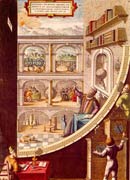
Tycho Brahe and his groovy mural quadrant
Tycho Brahe, of Danish noble stock, was probably the greatest astronomical observer of the pre-telescope era. Early observations in the 560's revealed inaccuracies with existing tables and spurred him onto making systematic, long-term observations and records. This task would occupy the residual of his life. With generous funding from the Male monarch of Kingdom of denmark he established a dedicated observatory, Uraniborg, on the island of Hven (at present Ven). He built big instruments such as quadrants from forest and contumely that improved on earlier designs. The measurements he made were up to x times more accurate than any preceding ones and were at the limit of that obtainable by the unaided eye. The investment by the Danish Rex amounted to v% of his full income, still a tape for investment on scientific research. Brahe eventually roughshod out with the Danish courtroom and moved to Prague for his final years.
In Nov 1572 a new star appeared in the constellation Cassiopeia. Brahe'southward observations showed that it was motionless relative to nearby stars suggesting to him that it was in fact a star and not a tail-less comet. Five years later he observed a bright comet and discerned no parallax and placed it at least six times farther from Globe than the Moon. Both of these observations challenged the Aristotelian orthodoxy. The stars were supposed to exist changeless and perfect whilst comets were supposed to be confined to the sub-lunary sphere, that is between the Earth and Moon. Further observations revealed that the comet would motility through the solid crystalline spheres of an Aristotelian Universe.
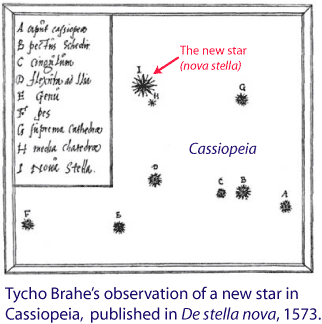
To reconcile his observations with his philosophy Brahe adult his ain model, incorporating some aspects of Copernicus' but rejecting the idea of a moving Earth. Although his hybrid model enjoyed a cursory catamenia of popularity information technology was soon replaced by the piece of work of his assistant, Johannes Kepler.
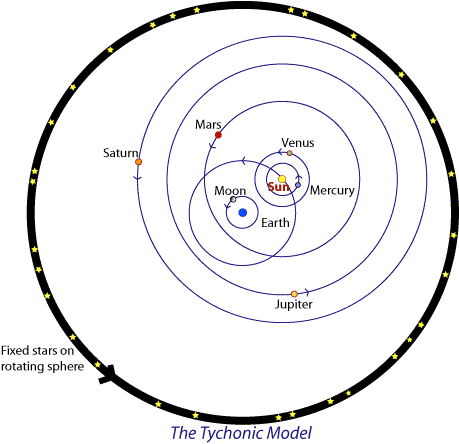
Tycho Brahe's Model:
Brahe's model was somewhat of a hybrid and drew upon Herakleide's earlier concepts. It had a static Earth at the centre of the Universe with the Moon orbiting it. A rotating sphere of fixed stars as well revolved around the Earth one time every 24 hours. The planets however orbited about the Sunday which itself orbited the Earth. It utilised epicycles, deferents and equants. In his model in that location is no demand for stellar parallax. The diagram to a higher place shows a simplified representation.
Brahe's lasting legacy was his long-term and meticulous observations of planetary motions, especially those of Mars. This information was used afterward his death past Kepler, who worked as his assistant during Brahe'south last year.
Johannes Kepler (1571 - 1630)

Johannes Kepler
Best known for his key works on astronomy, Johannes Kepler made valuable contributions in other fields. In his works on optics he examined the refraction of lite, correctly explained the working of the eye for the beginning fourth dimension and provided a theoretical basis for telescopes with suggested ways of improving them. His explanation on the new Napierian logarithms did much to encourage their wide acceptance. Given a challenge to calculate volumes of wine casks he concluded up developing an approach to infinitesimal calculus well ahead of the ideas of Liebniz and Newton. Kepler had studied under the renowned astronomer Michael Maestlin, one of the first proponents of Copernicus' work.
In his first astronomical piece of work, Mysterium cosmographicum (The cosmic mystery) in 1596, Kepler upheld his belief in the Copernican organization. He besides discovered a geometrical human relationship for the orbits of the planets around the Sun. Between the sphere of each planet'due south orbit he found he could place one of the five regular solids, for example a cube between Jupiter and Saturn, then that the six planets were separated by five regular solids. This system reflects the influence on Kepler of the Platonic-Pythagorean tradition of matching order in nature with the regularities of mathematics. Of greater long-term importance still was his suggestion that the Dominicus somehow affected the orbits of the planets, perhaps by magnetism.
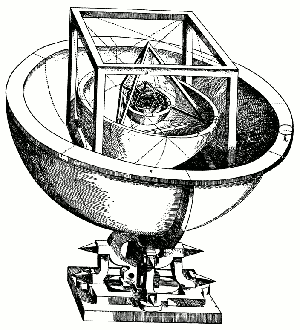
Kepler's geometrical relationship in the Solar System as shown in his Mysterium cosmographicum of 1596.
Kepler tried to fit Brahe's information to the Copernican model but consistently arrived at errors of at to the lowest degree eight seconds of arc, small but non insignificant. He was finally forced to carelessness the concept of uniform circular orbital paths but it was to take him several years of painstaking, methodical calculations before he arrived at an alternating model that fitted Brahe's 20 years of data on Mars. The results were published in 1609 in his work Astronomica nova (New Astronomy). In it he explained what are now known equally his offset 2 laws of planetary motion.
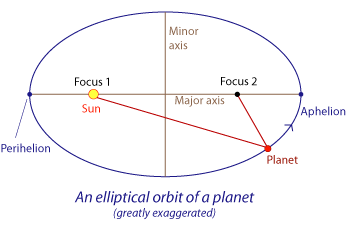
Kepler's 1st Law: The Law of Ellipses.
All planets orbit the Sun in elliptical orbits with the Dominicus as 1 common focus. Note the eccentricity of the ellipse has been greatly exaggerated in the above diagram. For nearly planets their orbits are almost circular.
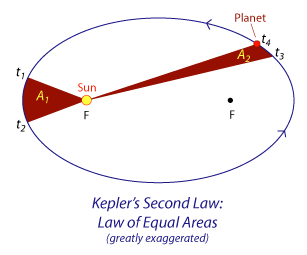
Kepler's 2d Law: The Law of Equal Areas.
The line between a planet and the Dominicus (the radius vector) sweeps out equal areas in equal periods of fourth dimension.
In the diagram, the time interval ttwo -tone = tfour -t3 and then the areas swept through in equal times are equal,
that is A1 = A2 .
This effect is very noticeable in comets such every bit Comet Halley that have highly elliptical orbits. When in the inner Solar System, shut to the Dominicus at perihelion, they move much faster than when far from the Sun at aphelion.
Kepler actually formulated the law of equal areas first and it so led him to the law of ellipses. His 3rd police force was not published until 1618 in Harmonice mundi (The Harmony of the Globe). This resulted from his attempts to notice a relationship between the distance of a planet from the Lord's day and its orbital catamenia.
Kepler'south 3rd Law: The Police of Periods or the Harmonic Law*.
The square of a planet'due south menstruum, T, is directly proportional to the cube of its boilerplate altitude from the Sun, r.
Mathematically this can be expressed every bit:
T2 ∝ rthree
or T2 /rthree = k (1.1)
where grand is a constant and the aforementioned for all planets or orbital bodies (such equally comets) in a given organisation.
If T is measured in Globe years and r in astronomical units (AU) then for the World, T = 1 and r = 1 so:
T2 /r3 = grand
∴ one/ane = k
ie. k =1
(* Notation this equation is not explicitly required for 8.5 The Cosmic Engine unit of measurement in the NSW Preliminary Course. It is, however, explicitly required in Unit of measurement 9.2 Space in the HSC course.)
The implication of Kepler's Third Law is that planets more afar from the Sun take longer to orbit the Sunday. Allow us run into how this can be used to determine the hateful distance of Mars from the Sun if its orbital menses is i.88 World years.
If T2 /r3 = k (i.1)
Then rewriting for r
r3 = T2 /k
r = ((1.88)2/1)ane/iii
so r = one.524 AU
So Mars is 1.524 astronomical units from the Sun.
Kepler's laws of planetary motion were empirical, they could predict what would occur but could not account for why planets behaved in such a manner. His Rudolphine tables of planetary motion published in 1627 were more accurate than nay previous ones. He came close to uncovering the concept of gravitation and corresponded with Galileo and was aware of his telescopic discoveries.
Source: https://www.atnf.csiro.au/outreach/education/senior/cosmicengine/renaissanceastro.html
0 Response to "what advantage did tycho have compared to other astronomical observers of his time"
Postar um comentário